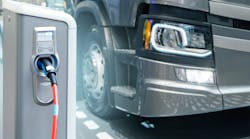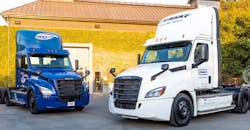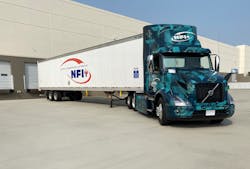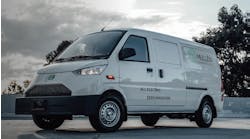Momentum is growing for heavy-duty electric truck adoption, but a lot of work remains for successful, full-scale fleet adoption.
Charging infrastructure remains a problem, and an entire ecosystem around infrastructure, charging needs, and funding is needed to push electrification for commercial trucks. And those who are testing electric trucks in southern California believe there is an evolution that will take the better part of this decade to meet the expectations of today’s heavy-duty applications.
Daimler Trucks North America (DTNA) and Volvo Trucks North America (VTNA) have been learning the ins and outs of what it will take to bring fully electric truck adoption to scale. In southern California, the two OEMs are working with the South Coast Air Quality Management District (AQMD), the regulatory agency responsible for improving air quality in the south coast basin of southern California.DTNA continues to gather insights from its Freightliner Electric Innovation Fleet, a demonstration of 30 pre-commercial heavy-duty battery-electric Freightliner trucks with two fleets, NFI Industries and Penske Logistics. DTNA is also gleaning information from its Customer Experience (CX) Fleet project, where eight pre-commercial heavy-duty battery-electric trucks are being rotated through more than a dozen fleets on short-term pilot demonstrations. Through Volvo LIGHTS, a collaboration between VTNA, South Coast AQMD, and 13 other public and private stakeholders, fleets Dependable Highway Express (DHE) and NFI are testing Volvo VNR electric trucks, as well as electric forklifts and yard tractors.
“The California Air Resources Board (CARB) and Energy Commission put significant money on the table for us to engage with the heavy-duty truck manufacturers to develop and do early commercial demonstrations of Class 8 battery-electric trucks,” explained Matt Miyasato, chief technologist for the South Coast AQMD, during a recent ACT News webinar. “2021 promises to be a great year and we are really poised to take these trucks from the demonstration phase to the prototype phase to where we are going to see some early commercialization and deployment.”
Lessons learned
Along their electrification journeys, both DTNA and Volvo are learning the value of partnerships and real-world testing. But both OEMs are also looking to make sure that they are developing electric trucks that fulfill the industry’s high-quality expectations.
DTNA’s Freightliner Innovation Fleet was the first real-use application of Class 6 and Class 8 trucks pulling real loads from real shipping docks, noted Michael Scheib, head of product management for DTNA. The fleet consists of 10 medium-duty eM2s and 20 heavy-duty eCascadias. It has been testing in a variety of applications, including drayage, regional and local delivery, food distribution, and parcel delivery.
In two years, DTNA has collected 300,000 miles’ worth of data. With financial support from the South Coast AQMD, DTNA added the CX Fleet.
“Those are the kind of partnerships we need going forward to further increase the zero-emission penetration,” Scheib said. “So, it is not the OEM only. We still need to work on getting the cost down on these products to get to a TCO [total cost of ownership] level. We also need the infrastructure because it is one of the biggest impacts for TCO to make these products successful in the market.”
Scheib added that when it comes to TCO, certain segments will see a faster payback for electric trucks. DTNA created an internal service for charging infrastructure at customer depots, worked with its dealer network to prepare qualified dealers for repairing electric trucks, and built a site called “Electric Island” to fully test charging infrastructure.
“We are definitely looking into hardware for infrastructure because the single, number-one failure we had in the Innovation Fleet is the failure to charge,” Scheib pointed out. He also added that a fire at one charging station revealed the necessity to ensure that both charging software and hardware work and are seamlessly integrated with the truck.
DTNA also learned the hard way that if charging stations are on a slight slope and a truck is plugged in without emergency brake activation, the truck is at risk of rolling away.
“We had this happen too,” Scheib said. “These are not things you want to learn, but these are all things that you start learning when you start testing with the customer.”
VTNA also learned first-hand the value of collaboration with various partners throughout the Volvo LIGHTS project, noted Keith Brandis, vice president of Partnerships & Strategic Solutions.
The Volvo LIGHTS project began two years ago and is the largest private-public partnership in the Volvo Group, totaling some $90 million. The initiative began as a research and development project on how to bring electric trucks into the U.S. and has since evolved into a complete demonstration of the ecosystem needed to roll out freight electrification in the U.S., Brandis explained.
Two VTNA fleet customers DHE and NFI agreed to put roughly 23 Volvo VNR battery-electric trucks into their fleet and run daily operations. VTNA also replaced freight handling equipment for both drayage providers with electric forklifts and electric yard tractors. VTNA has also partnered with San Bernardino and Rio Hondo community colleges to train the next generation of the workforce who will eventually operate and maintain commercial electric trucks.As part of its workforce development program with Rio Hondo, VTNA has trained nearly 50 technicians. VTNA provides heavy-duty electric prototype parts that students can break down and examine how they function. The goal is that aspiring technicians will be ready for hire when they receive their certification.
Volvo VNRs retrofitted with electric drivelines have already been proven over hundreds of thousands of miles with Volvo buses and medium-duty trucks in Europe, Brandis noted. He added that VTNA has now optimized more than 52,000 miles with DHE and NFI. Volvo also announced in December 2020, that it was taking the VNR electric into full-scale production.
“Charging infrastructure has been one of the larger challenges for us in this project,” Brandis stressed. “Each locality has their own inspection, permitting, and approval processes, so we have to get very granular. I think it’s going to be quite a challenge to rollout a nationwide charging network until we have more standards in place and until we are able to move even faster to charging level supplier.
“We are making sure that each site is fully energized and commissioned with reporting back to the fleet owner so they can see how much energy is being used and the state of charge of each vehicle, so the fleet owner has the tools that they need to make the decisions on whether that truck is ready to go, which route can it can be put on, and how the fleet can get the maximum benefit,” he continued.
Brandis also noted that VTNA has been working to train the first responders in the communities where these trucks will operate and be seen.
“It’s not enough to say we’ll wait until something happens,” Brandis said. “We want to get ahead of it. We’re providing the point-by-point steps that each one of the fire and rescue departments would like to have before they arrive on the scene for any heavy-duty truck.”
Infrastructure, cost top of mind
When conducting site assessments and walkarounds with fleets, VTNA’s Brandis pointed out that real estate is incredibly expensive in southern California and that carving out a portion of a fleet’s facility for charging infrastructure is disruptive to a fleet’s entire operation. Fleets have expressed concerns of their depots being under constant construction with congestion and moving equipment around with more widespread electric truck adoption.
VTNA and its partners are also asking state agencies to take a more consolidated and longer-term view to which corridors would make sense to plan for public and private charging stations.
“When we met with the localities, they each had their own views on how to provide permits and inspections,” Brandis explained. “It’s just all new and they don’t have the blueprint necessary yet. But we have seen a lot of support from the California Energy Commission, as well as the air districts. They recognize that we have to have funding for charging infrastructure as well as for the higher capital costs for these initial trucks.”
South Coast AQMD’s Miyasato also stressed that infrastructure is a huge problem.
“We’re looking at 200,000 to 400,000 trucks in southern California and in order to turn over that huge amount of vehicles in a short amount of time, you need not only the big guys like Daimler, Volvo, Kenworth and Peterbilt, and the other startups that come along, but you need infrastructure,” Miyasato explained. “That has to be the theme of how we move forward on the collaboration. We need everyone to be pulling forward in the same direction.”
He also noted that fuel cells will be needed sooner than later to serve long-haul routes. Plus, state and federal agencies will need to help advance zero-emission technologies, he said.
Scheib anticipates that by 2025 there could be full-scale adoption of battery-electric trucks that operate up to 300 miles and then scale up from there. DTNA and Volvo recently founded a joint venture to advance technologies, like fuel cells, for extreme high mileages.
Brandis added that for now, the focus for electric truck deployment must start with the high-density, high-populated areas first, where most truck routes are 100 to 150 miles. Then, he said, VTNA will work with both the battery technology as well as charging corridors to expand, and that will improve to 250-300 miles.
“This is an evolution that will take the better part of this decade before we see the complete mix of everything that will meet all of the expectations of all the typical heavy-duty applications today,” Brandis explained.






